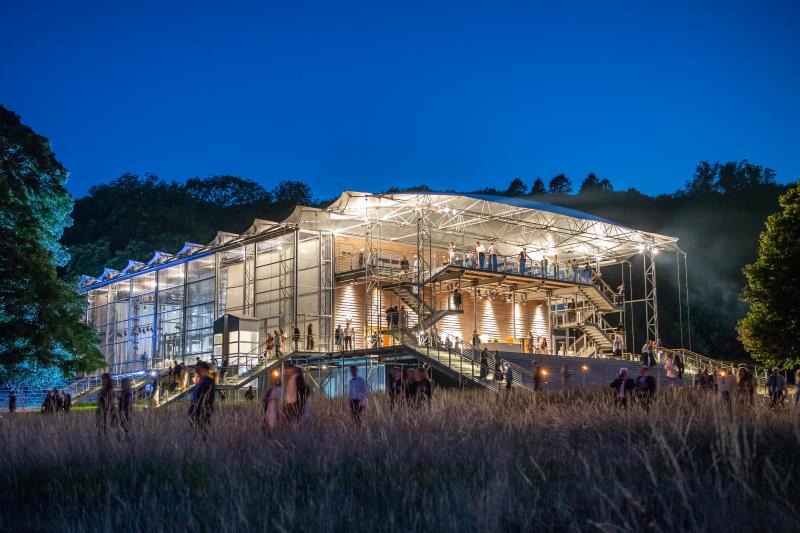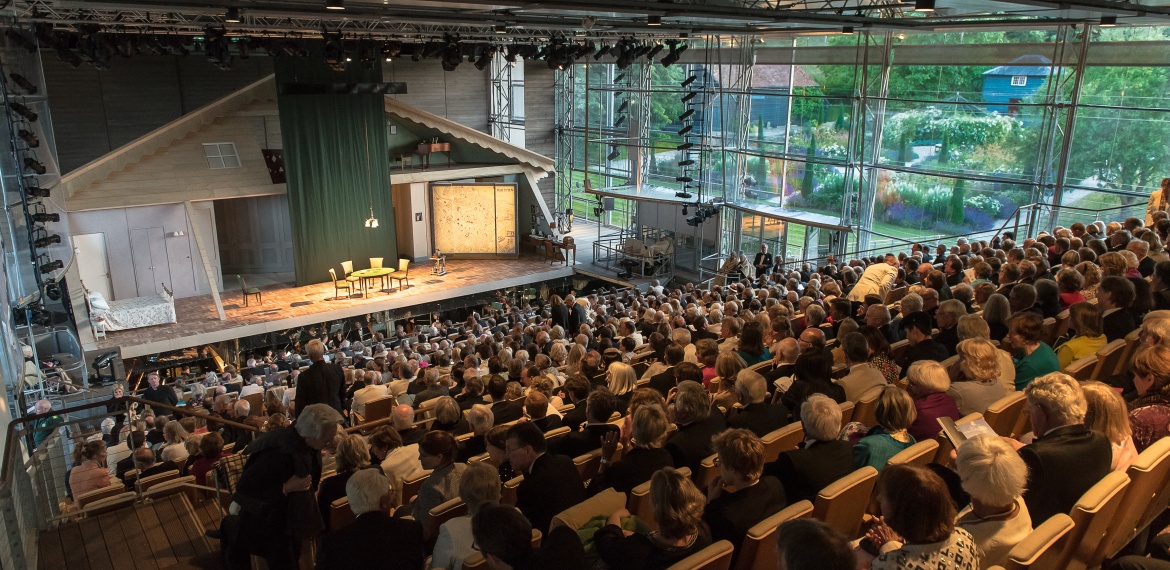Monteverdi Vespers, Cummings, The English Concert, Garsington Opera Chorus review – Gloria in the Chilterns | reviews, news & interviews
Monteverdi Vespers, Cummings, The English Concert, Garsington Opera Chorus review – Gloria in the Chilterns
Monteverdi Vespers, Cummings, The English Concert, Garsington Opera Chorus review – Gloria in the Chilterns
A thrilling, operatic take on this spectacular musical showcase

Scholars still wrangle over the work now known as Monteverdi’s Vespers of 1610. Was this an integral piece written for a single liturgical occasion, or a sort of anthology of luxury items assembled to help the composer’s bid to escape the underpaid drudgery of life at the Mantuan court and win the top post at St Mark’s in Venice?
If the modern performance history of the Vespers splits into ecclesiastical and theatrical camps, then this felt like an unapologetically operatic evening. The airy yet intimate pavilion at Wormsley (pictured below by Clive Barda), where scents from the flower garden wafted in on a cooling breeze as the light of a scorching day dwindled, is an opera house, after all. And the Monteverdi celebrated here was the creator of Orfeo and L'incoronazione di Poppea rather than the genius journeyman shackled to the church’s calendar. PJ Harris’s staging, and Rob Casey’s lighting, accentuated every moment of drama as chorus and soloists moved around the stage (and sometimes stalked the auditorium as well). Bigger groups morphed into smaller units, then reassembled. Single singers, or sometimes half the choir, occupied the two upper galleries on either side of the stage. As dusk fell, spotlights in the gathering gloom pulled off a succession of visual coups.
 None of which would have counted for much without the thrilling dynamism of the performances. Cummings’s jumping exuberance (while managing to play the harpsichord and organ continuo as well) set the tone for a Vespers which wrung every grain of dramatic force from its setting of a mixed bag of Marian texts, rounded off with a Magnificat of jaw-dropping virtuosity. This is unashamedly show-off music, as skin-prickingly exciting now as four centuries ago (so, Garsington, why such a colourless treatise about it in the programme?). The Garsington chorus, swooping over a vast dynamic range, sometimes divided antiphonally in those upper galleries, and sometimes massed in a semicircular line behind the musicians of The English Concert. In sections such as the “Laetatus sum”, the “Nisi dominus” and the farewell blast of “Sicut erat”, their fortissimo climaxes matched for sheer theatrical impact anything on the Garsington (or any other operatic stage) this summer. There was delicate shading too in the meditative interludes, and fierce attention to words as well as sound. The titles projected onto the back screen, in Latin and English, proved a welcome bonus. In the parts that require extra solo voices, individual chorus members rose nobly to the challenge. Spread around the hall during the heavenly meteor-shower of “Sancta Marias” that concludes the “Sonata”, a host of sopranos filled the Garsington pavilion with a choir of angels.
None of which would have counted for much without the thrilling dynamism of the performances. Cummings’s jumping exuberance (while managing to play the harpsichord and organ continuo as well) set the tone for a Vespers which wrung every grain of dramatic force from its setting of a mixed bag of Marian texts, rounded off with a Magnificat of jaw-dropping virtuosity. This is unashamedly show-off music, as skin-prickingly exciting now as four centuries ago (so, Garsington, why such a colourless treatise about it in the programme?). The Garsington chorus, swooping over a vast dynamic range, sometimes divided antiphonally in those upper galleries, and sometimes massed in a semicircular line behind the musicians of The English Concert. In sections such as the “Laetatus sum”, the “Nisi dominus” and the farewell blast of “Sicut erat”, their fortissimo climaxes matched for sheer theatrical impact anything on the Garsington (or any other operatic stage) this summer. There was delicate shading too in the meditative interludes, and fierce attention to words as well as sound. The titles projected onto the back screen, in Latin and English, proved a welcome bonus. In the parts that require extra solo voices, individual chorus members rose nobly to the challenge. Spread around the hall during the heavenly meteor-shower of “Sancta Marias” that concludes the “Sonata”, a host of sopranos filled the Garsington pavilion with a choir of angels.
 As for the five soloists themselves, their stars blazed in the Chilterns twilight with an equal radiance. Sisters Sophie Bevan and Mary Bevan (pictured above) never stinted on lustre and succulence of sound. The ecclesiastical purists would maybe not have approved; their listeners did. Their duet in the “Pulchra es” was as ravishing as I had hoped, and one of several episodes when sensitively judged movement, staging and lighting lent an extra gear to the performance as a whole. The three tenors (Benjamin Hulett, Robert Murray and James Way) soon matched the Bevan sister act in the sublime “Duo seraphim”, with Monteverdi’s beloved echo effects adding their own unearthly touch in the deepening gloom. Here, as elsewhere, their vocal decorations dazzled, but the tenors never lost a propulsive sense of pulse and drive. Accompanied by William Carter’s exquisite theorbo, Murray’s solo in “Nigra sum” showed that Cummings’ high-energy, high-impact direction did not rule out passages of tranquil grace. Indeed, the interchange between introspective solos and choral grandeur proved a hallmark of the show; nowhere better than in the “Ave maris stella”, with the Bevans and Way (who impressed at every turn) positioned around the stage for their beautiful invocations, while the split choir hymned the Blessed Virgin from their galleries above.
As for the five soloists themselves, their stars blazed in the Chilterns twilight with an equal radiance. Sisters Sophie Bevan and Mary Bevan (pictured above) never stinted on lustre and succulence of sound. The ecclesiastical purists would maybe not have approved; their listeners did. Their duet in the “Pulchra es” was as ravishing as I had hoped, and one of several episodes when sensitively judged movement, staging and lighting lent an extra gear to the performance as a whole. The three tenors (Benjamin Hulett, Robert Murray and James Way) soon matched the Bevan sister act in the sublime “Duo seraphim”, with Monteverdi’s beloved echo effects adding their own unearthly touch in the deepening gloom. Here, as elsewhere, their vocal decorations dazzled, but the tenors never lost a propulsive sense of pulse and drive. Accompanied by William Carter’s exquisite theorbo, Murray’s solo in “Nigra sum” showed that Cummings’ high-energy, high-impact direction did not rule out passages of tranquil grace. Indeed, the interchange between introspective solos and choral grandeur proved a hallmark of the show; nowhere better than in the “Ave maris stella”, with the Bevans and Way (who impressed at every turn) positioned around the stage for their beautiful invocations, while the split choir hymned the Blessed Virgin from their galleries above.
 Robust or refined, as the score demanded, The English Concert enjoyed a stellar evening of their own. In the “Sonata” that gives the orchestra their big showcase, the cornets and sackbuts (on their feet) made their instruments skip and dance with an exhilarating dexterity. Violinists Nadja Zwiener and Elizabeth McCarthy stood up too for their solo roles, executed with rhythmic vigour and a piercing lucidity of tone. The acrobatic cornets (feathered hats off to Gawain Glenton, Conor Hastings and Nicholas Parry) excelled too in the Magnificat, while the twin theorbos (Carter and Alex McCartney) added a chamber flavour to the more contemplative segments of this multi-faceted masterwork.
Robust or refined, as the score demanded, The English Concert enjoyed a stellar evening of their own. In the “Sonata” that gives the orchestra their big showcase, the cornets and sackbuts (on their feet) made their instruments skip and dance with an exhilarating dexterity. Violinists Nadja Zwiener and Elizabeth McCarthy stood up too for their solo roles, executed with rhythmic vigour and a piercing lucidity of tone. The acrobatic cornets (feathered hats off to Gawain Glenton, Conor Hastings and Nicholas Parry) excelled too in the Magnificat, while the twin theorbos (Carter and Alex McCartney) added a chamber flavour to the more contemplative segments of this multi-faceted masterwork.
All the smart but unintrusive stagecraft allowed Cummings (pictured above) and his forces to replicate the spatial drama of some great basilica in a light, modernistic structure on a country estate. For all-round musical excellence and reverberation-free acoustic clarity, however, it’s doubtful that the grandest of cathedrals or chapels could have equalled the experience at Wormsley. As the sultry evening dimmed into dark, the chorus shook the wooded hills around with their closing crescendos, and the final “Amen” of the “Sicut erat” struck like a thunderclap. Garsington Opera had hosted a spectacular testimonial to Monteverdi’s fitness for that plum Venetian job. Thankfully, for him, for us and for musical history, he got it.
rating
Explore topics
Share this article
The future of Arts Journalism
You can stop theartsdesk.com closing!
We urgently need financing to survive. Our fundraising drive has thus far raised £49,000 but we need to reach £100,000 or we will be forced to close. Please contribute here: https://gofund.me/c3f6033d
And if you can forward this information to anyone who might assist, we’d be grateful.

Subscribe to theartsdesk.com
Thank you for continuing to read our work on theartsdesk.com. For unlimited access to every article in its entirety, including our archive of more than 15,000 pieces, we're asking for £5 per month or £40 per year. We feel it's a very good deal, and hope you do too.
To take a subscription now simply click here.
And if you're looking for that extra gift for a friend or family member, why not treat them to a theartsdesk.com gift subscription?
more
 'We are bowled over!' Thank you for your messages of love and support
Much-appreciated words of commendation from readers and the cultural community
'We are bowled over!' Thank you for your messages of love and support
Much-appreciated words of commendation from readers and the cultural community
 Album: Claudia Brücken - Night Mirror
The Propaganda singer returns with an album of elegant, varied grown-up pop
Album: Claudia Brücken - Night Mirror
The Propaganda singer returns with an album of elegant, varied grown-up pop
 Jurassic World Rebirth review - prehistoric franchise gets a new lease of life
Scarlett Johansson shines in roller-coaster dino-romp
Jurassic World Rebirth review - prehistoric franchise gets a new lease of life
Scarlett Johansson shines in roller-coaster dino-romp
 Album: Mocky - Music Will Explain (Choir Music Vol. 1)
Is the Canadian polymath hiding behind his exquisite production and arrangement skill?
Album: Mocky - Music Will Explain (Choir Music Vol. 1)
Is the Canadian polymath hiding behind his exquisite production and arrangement skill?
 Semele, Royal Opera review - unholy smoke
Style comes and goes in a justifiably dark treatment of Handelian myth
Semele, Royal Opera review - unholy smoke
Style comes and goes in a justifiably dark treatment of Handelian myth
 Le nozze di Figaro, Glyndebourne review - perceptive humanity in period setting
Mostly glorious cast, sharp ideas, fussy conducting
Le nozze di Figaro, Glyndebourne review - perceptive humanity in period setting
Mostly glorious cast, sharp ideas, fussy conducting
 Quadrophenia, Sadler's Wells review - missed opportunity to give new stage life to a Who classic
The brilliant cast need a tighter score and a stronger narrative
Quadrophenia, Sadler's Wells review - missed opportunity to give new stage life to a Who classic
The brilliant cast need a tighter score and a stronger narrative
 Fidelio, Garsington Opera review - a battle of sunshine and shadows
Intimacy yields to spectacle as Beethoven's light of freedom triumphs
Fidelio, Garsington Opera review - a battle of sunshine and shadows
Intimacy yields to spectacle as Beethoven's light of freedom triumphs
 Album: Brìghde Chaimbeul - Sunwise
A singular sonic auteur reshapes traditional Celtic music
Album: Brìghde Chaimbeul - Sunwise
A singular sonic auteur reshapes traditional Celtic music
 Summer Laugh review - five comics gear up for the Fringe
Terrific initiative by Scottish stand-ups
Summer Laugh review - five comics gear up for the Fringe
Terrific initiative by Scottish stand-ups
 Music Reissues Weekly: Rupert’s People - Dream In My Mind
How ‘A Whiter Shade of Pale’ transformed a London mod-pop band
Music Reissues Weekly: Rupert’s People - Dream In My Mind
How ‘A Whiter Shade of Pale’ transformed a London mod-pop band

Add comment